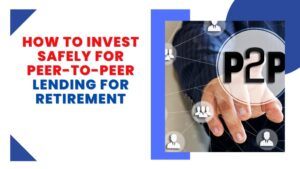Welcome to this post on how to invest safely in peer-to-peer lending for retirement.
Peer-to-peer (P2P) lending -in terms of retirement planning is one more piece of the puzzle that can potentially add value to your nest egg.
Here’s a rundown of Peer-to-peer basically, it’s a way for individuals to lend money directly to others without the involvement of a traditional financial institution. Think of it as a financial matchmaker that connects someone who wants to borrow money with someone who wants to invest money.
The platform, usually a website or a mobile app, handles the details. What’s enticing here is that lenders can often earn higher returns compared to traditional savings or investment products.
You’re going to find out that P2P lending isn’t the same as putting money into stocks or a savings account. It’s a unique space where you can potentially see higher returns, but this does come with its own set of challenges and risks, which will be talked about in the next section.
Including P2P lending in a retirement portfolio can be beneficial, and I’m not just talking about diversification. It can offer a stream of regular income, which is quite appealing when you’re looking to have a steady flow of cash during your golden years.
In my opinion, it’s essential to approach P2P lending with a clear-eyed view of where it fits into your overall retirement strategy. It should complement, not replace, other investment avenues you’re already exploring or have in place.
Now let’s chat on how to assess and manage the potential risks while maximizing the rewards for your retirement.
FREE 4-STEP “CHEAT SHEET” :
Want To Build a PROFITABLE Online Business(but don’t know where to start?)
What are The Risks and Rewards of P2P Lending for Retirees?
One of the rewards is that it can offer you a passive income return. This can provide a steady stream of income to supplement your pension and Social Security.

It can also offer you diversification to your retirement portfolio. Unlike traditional investments that are linked to the stock market, P2P loans are based on individual borrower creditworthiness, offering a potential hedge against market fluctuations
Another cool perk is that P2P lending can offer potentially higher returns on your investment. However, it’s important to remember that higher potential returns often come with higher risks.
I’m going to lay out the risks you’re up against. Now, P2P lending platforms connect borrowers with investors like you, but without the traditional financial institutions as middlemen.
That sounds great, but it also means you take on the risk if borrowers default. Just like any investment, P2P lending isn’t a guaranteed win. There is also the possibility of late payments or defaults, which could affect your returns.
So, how do you keep your shirt on in this game?
Well, diversification is key. Just as you wouldn’t put all your eggs in one basket when buying stocks, you shouldn’t put all your cash in one borrower’s hands. Spread your investments across various loans with different risk levels to manage potential losses better.
Recommended Reading: Best Ways To Supplement Your Retirement Income
Getting Started with P2P Lending: A Step-by-Step Guide for Retirees
This isn’t just about tossing your money into the first platform you find; it’s about smart, informed decision-making.
Choosing the right P2P lending platform is your first crucial step.

Invest in platforms that are reputable and have a strong track record, robust security measures, and clear fee structures.
Do your research on borrower creditworthiness, loan purpose, and repayment terms. Read reviews from other investors, and understand the terms of investment. This due diligence is essential to mitigate risk and align your choices with your risk tolerance.
Next, you’ll learn the nuts and bolts of setting up your P2P account. It typically involves providing some personal information, setting up a way to fund your account, and agreeing to the platform’s terms. Choose something that resonates with you in terms of ease of use and customer support.
If you want to dip your toes before diving in, start with a small investment. This strategy allows you to gauge the platform’s service and see real returns without overexposing yourself. You’ll gain firsthand experience, which is invaluable.
A lot is happening very quickly once you’re up and running, so you’ll want to stay on top of your investments. This brings me neatly to the best practices you should uphold to manage your P2P investment effectively over time, ensuring it continues to serve your retirement needs.
Recommended Reading: 4 Best Low-Risk Investments for Retirees
Best Practices for Managing a P2P Lending Investment Over Time
Once you’ve dipped your toes into the world of peer-to-peer lending, it doesn’t end there. The ability to oversee and adjust your investments is key to maintaining a healthy portfolio suited for retirement.
In this section, I’m going to help you with the essentials of managing your P2P lending investment to help ensure long-term success.
First off, you’re going to find out about the importance of monitoring your investments regularly. You don’t need to check it every day, but setting aside time each month to review the performance of your loans can be invaluable. Look for any significant changes in borrower repayments or the financial health of the loans you’re invested in.
Now, as the financial markets shift or as you get closer to retirement, your goals might change. It’s crucial to adjust your P2P investment strategy accordingly. If you need to lower risk, for instance, you might shift focus from high-return, high-risk loans to those that are more stable but offer lower returns. Take a look at my post on low-risk investments for retirees here CTA
Reinvesting your returns can enhance the growth of your retirement fund due to the power of compounding interest. Whenever you earn interest from your loans, rather than withdrawing it, consider reinvesting this into new loans. This can increase your earnings over time, but always ensure it aligns with your retirement strategy.
And let’s talk exit strategies—because eventually, you’ll want to. Establishing a clear exit strategy is essential. Depending on the P2P platform you choose, there may be options to sell your loans to other investors or to gradually withdraw funds. Plan this to avoid any surprises when you need access to your money.
So now, you are all clued up on the ongoing management of your P2P investment. But where can you go for more information? That’s what I’m going to cover next.
Supplemental Resources and Further Learning
I’m going to wrap this up by pointing you in the direction of some valuable resources. The world of P2P lending is dynamic, and staying updated is key to success, especially as you near or enjoy retirement.
For a deep dive into the ins and outs of P2P lending, check out sources like the Peer-to-Peer Finance Association or the Lending Club’s Resource Center. They provide not just the basics but also nuanced details that can inform your investment decisions.
If you want to keep learning about safe investment practices, websites like Investopedia offer a wealth of free educational content, explained in a way that’s easy to grasp.
Joining online communities, such as those on Reddit, can give you access to discussions and success stories from other retirees who are actively investing in P2P lending. You’re going to find out about the real-world experiences that can prove invaluable.
And don’t overlook the benefit of professional financial advice. Sites like the Certified Financial Planner Board of Standards can help you connect with certified professionals. When your investment case gets complex, or you’re just looking for that extra bit of peace of mind, the right advisor can make a world of difference.
Remember, investing wisely in P2P lending for retirement isn’t just a one-time task—it’s an ongoing commitment to learning and adapting. I hope that you find these resources as useful starting points and that they help keep your investments thriving well into your golden years.
Conclusion: Building a Secure Retirement with P2P Lending (But Not Going It Alone)
Retirement should be a time of freedom, exploration, and enjoying the fruits of your labor. But a solid financial foundation is essential for peace of mind.

P2P lending can be a compelling option for retirees seeking to generate passive income and potentially achieve higher returns than traditional savings accounts.
In this article, we covered how P2P lending can boost retirement income, along with the inherent risks. We also chatted about strategies for safe investing, platform selection, and ongoing portfolio management.
P2P lending can be a valuable tool in your retirement planning toolbox, but it’s not a substitute for a comprehensive financial strategy. Feel free to check out my article on the best online side hustles for seniors.
Building and managing a successful P2P lending portfolio alongside your existing retirement investments requires knowledge, discipline, and potentially, some expert guidance.
Perhaps you’ve always dreamed of starting your own online business but weren’t sure where to begin.
This is where my number one recommendation for getting started comes in! This platform offers a comprehensive suite of courses and resources designed to equip individuals with the skills and knowledge to launch and thrive in the online business world.
Imagine leveraging your financial expertise and experience to help others achieve their retirement goals through P2P lending or other investment strategies.
Ready to explore the exciting world of online entrepreneurship?
- Consider downloading my free guide, “10-Steps to Blast Off With Your PROFITABLE Online Affiliate Marketing Business.
Take charge of your financial future and explore the possibilities of online business ownership. A fulfilling and prosperous retirement awaits!
Wishing you everything of the best in your retirement years.
Good Luck and Take Care
Regards
Roopesh

